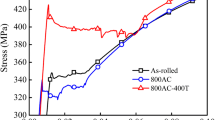Abstract
In this paper, a diffusion–reaction continuum damage model is proposed to study the oxidation behavior of high-Cr steels in supercritical water. The model is formulated based on a three-dimensional (3-D) setting. By considering the diffusion and reaction effects of free oxygen in a domain of solid material, a partial differential equation named as the diffusion–reaction equation is derived, which contains an oxidation damage variable representing the fraction of the oxidized metal at a local material point. The evolution equation of the oxidation damage variable can also be derived, which together with the diffusion–reaction equation formulates the governing system of the model. To show the efficiency of the model, a 1-D problem is first studied. By taking P92 steel as an example, the values of the parameters in the governing system are determined. Based on the numerical solutions to the governing system, some key features of the oxidation behavior of high-Cr steel sample are analyzed. The influences of the parameters on the oxidation process have also been discussed. The model is further implemented into the ANSYS UserMatTh subroutine. Then, some typical examples of FEM simulations are introduced. It can be seen that our current model is suitable to simulate the global oxidation behaviors of high-Cr steel specimens with different geometrical shapes and subject to different boundary conditions. Therefore, the model would be helpful for the design and residual lifetime evaluation of high-Cr steel components in practical applications.
Graphic Abstract











Similar content being viewed by others
References
P. Ampornrat and G. S. Was, Journal of Nuclear Materials371, 1 (2007).
F. R. Biglari and K. M. Nikbin, Computational Materials Science84, 267 (2014).
F. R. Biglari and K. M. Nikbin, International Journal of Damage Mechanics26, 859 (2017).
Y. Chen, K. Sridharan and T. Allen, Corrosion Science48, 2843 (2006).
P. J. Ennis and A. Czyrska-Filemonowicz, Sadhana28, 709 (2003).
S. Fetni, A. Toumi, I. Mkaouar and C. Boubahri, Engineering Failure Analysis79, 575 (2017).
B. Fournier, M. Sauzay, C. Caes, M. Noblecourt, M. Mottot, A. Bougault, V. Rabeau and A. Pineau, International Journal of Fatigue30, 649 (2008).
C. Q. Fu, H. L. Ye, X. Y. Jin, N. G. Jin and L. L. Gong, Computers and Concrete15, 847 (2015).
H. C. Guo, D. M. Ji, J. Z. Tang, Q. Sun, C. Dai and J. X. Ren, Materials at High Temperatures36, 125 (2019).
H. Larsson, T. Jonsson, R. Naraghi, Y. Gong, R. C. Reed and J. Agren, Materials and Corrosion68, 133 (2017).
Y. H. Li, T. T. Xu, S. Z. Wang, B. Fekete, J. Yang, J. Q. Yang, J. Qiu, A. N. Xu, J. M. Wang, Y. Xu and D. D. Macdonald, Materials12, 3 (2019).
E. W. Lund, Journal of Chemical Education42, 548 (1965).
M. Montgomery, S. A. Jensen, F. Rasmussen and T. Vilhelmsen, British Corrosion Journal44, 196 (2009).
A. Nagode, L. Kosec, B. Ule and G. Kosec, Metalurgija50, 45 (2011).
S. Penttilä, A. Toivonen, L. Heikinheimo and R. Novotny, Nuclear Technology4, 74 (2008).
M. Pettiná, R. W. Harrison, L. J. Vandeperre, F. R. Biglari, P. Brown, W. E. Lee and K. Nikbin, Journal of the European Ceramic Society36, 2341 (2016).
M. Schütze, M. Schorr, D. P. Renusch, A. Donchev and J. P. T. Vossen, Materials Research7, 111 (2004).
Q. C. Sherman and P. W. Voorhees, Physical Review E95, 032801 (2017).
Y.Y. Sun, The Research of P92 Steel Oxidation Kinetics Considering of the Oxide Scale Voids in Supercritical Water. Master Thesis (North China Electric Power University, Beijing, 2016).
Y. H. Suo and S. P. Shen, Journal of Applied Physics114, 164905 (2013).
Y. H. Suo and S. P. Shen, Acta Mechanica226, 3375 (2015).
C. Wang, S. G. Ai and D. N. Fang, Acta Mechanica Sinica32, 881 (2016).
H. L. Wang, Y. H. Suo and S. P. Shen, Oxidation of Metals83, 507 (2015).
K. J. Yin, S. Y. Qiu, R. Tang, Q. Zhang and L. F. Zhang, The Journal of Supercritical Fluids50, 2009 (235).
M. A. Zaeem and H. E. Kadiri, Computational Materials Science89, 122 (2014).
C. L. Zhang, J. G. Li, Z. X. Zhang, N. Dong, J. Wang, Y. Liu, L. X. Ling and P. D. Han, AIP Advances8, 085104 (2018).
X. Y. Zhong, X. Q. Wu and E.-H. Han, Journal of Supercritical Fluids72, 68 (2012).
X. Y. Zhong, X. Q. Wu and E.-H. Han, Corrosion Science90, 511 (2015).
Acknowledgements
This work is supported by the Guangdong Natural Science Foundation for Distinguished Young Scholar (Project No.: 2015A030306009), Guangdong Special Support Plans for Young Scientists in Science and Technology (Project No.: 2016TQ03X532) and the Fundamental Research Funds for the Central Universities from SCUT (Project No.: x2tj/D2181310).
Author information
Authors and Affiliations
Corresponding author
Ethics declarations
Conflict of interest
The authors declare that they have no conflict of interest.
Additional information
Publisher's Note
Springer Nature remains neutral with regard to jurisdictional claims in published maps and institutional affiliations.
Rights and permissions
About this article
Cite this article
Li, Z., Wang, J. A Diffusion–Reaction Continuum Damage Model for the Oxidation Behaviors of High-Cr Steels in Supercritical Water. Oxid Met 94, 5–25 (2020). https://doi.org/10.1007/s11085-020-09975-6
Received:
Revised:
Published:
Issue Date:
DOI: https://doi.org/10.1007/s11085-020-09975-6




